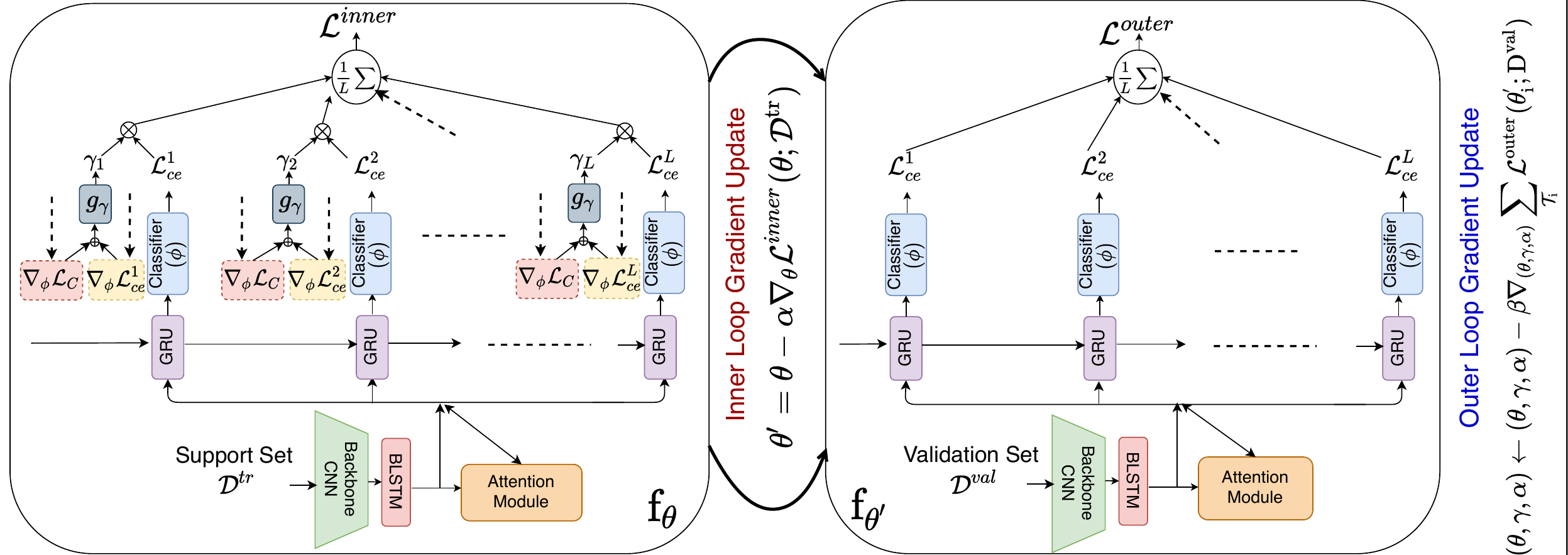Implementation of the 2021 CVPR paper titled "MetaHTR: Towards Writer-Adaptive Handwritten Text Recognition" by Bhunia et al. (Arxiv link).
The central idea is to use model-agnostic meta-learning (MAML) to make HTR models more adaptive to unseen writers. The figure above shows the optimization process, involving an inner loop (left) for writer-specific adaptation and an outer loop (right) for learning underlying "meta-knowledge", optimizing for weights that can be rapidly adapted to novel writers.
Compared to ordinary MAML, MetaHTR uses two additional ideas:
- Learnable layer-wise learning rates: replace the MAML inner loop learning rate hyperparameter with a vector of learnable learning rates. This is the same idea as MetaSGD [4] but applied layer-wise rather than parameter-wise.
- Character instance-specific weights: weigh the character-specific loss values according to their relative importance using learned weights. The weights are calculated by passing a subset of the model gradients through an MLP, followed by a sigmoid activation. See the original paper for more details.
MetaHTR [1] can be applied to most HTR models, due to its model-agnostic nature. The authors try out 3 base models in their paper. I include the following models in this repository:
- SAR [2]: LSTM-based architecture. Consists of a ResNet backbone, LSTM encoder, LSTM encoder, and 2D attention module. This model is also used in the MetaHTR paper.
- FPHTR [3]: Transformer-based architecture. Consists of a ResNet backbone combined with a Transformer decoder (original repo).
If you want to train these models yourself, they can be obtained from another Github repository, which can be found here. In the original paper, the authors apply MetaHTR to an already trained HTR model. It may also be possible to train a model using MetaHTR from randomly initialized weights, but in my experience this does not work very well (and takes quite some time to run). More realistically, MetaHTR is applied for 10-40 epochs on a trained model.
Word images from the IAM dataset are used for training/evaluating. Two examples of word images from IAM are shown above. Download the dataset here.
Run the instructions below to clone this repository and install all the necessary dependencies (tested using Python 3.8).
# Clone this repository.
git clone https://github.com/tobiasvanderwerff/MetaHTR.git
cd MetaHTR
git submodule update --init # initialize submodules
python3 -m venv env # create a new virtual environment
source env/bin/activate # activate the environment
pip install -r requirements.txt # install requirements
pip install -e . # install this repo as a package
pip install -e htr # install submodule containing base modelsTraining MetaHTR using FPHTR as the base model:
cd metahtr
python train.py --main_model_arch metahtr \
--base_model_arch fphtr \
--use_instance_weights \
--trained_model_path /path/to/torch/base/model/checkpoint \
--iam_dir /path/to/iam \
--learning_rate 3e-5 \
--shots 16 \
--ways 8 \
--use_cpuRun train.py -h to see a full list of arguments.
The eval.py script can be used to run evaluation on the IAM validation or test set.
For example:
cd metahtr
python eval.py --trained_model_path /path/to/metahtr/checkpoint \
--iam_dir /path/to/iam \
--use_cpuBelow you can see performance of MetaHTR on the IAM test set compared to a naive finetuning baseline, along with standard deviations. Performance is measured in word error rate (WER).
| FPHTR-18 | SAR-18 | FPHTR-31 | |
|---|---|---|---|
| Baseline | 20.0 ± 0.2 | 20.6 ± 0.6 | 15.3 ± 0.7 |
| MetaHTR | 18.6 ± 0.4 | 18.6 ± 0.5 | 13.5 ± 0.2 |
When running the training or evaluation script, you will most likely see two of the following warnings:
UserWarning: Found keys that are in the model state dict but not in the checkpoint: [...]
This warning can safely be ignored. It occurs because the weights from a checkpoint are loaded in two stages: first, the weights of the base model are loaded, and second, the weights of the meta-model are loaded (if they exist). Pytorch Lightning will complain because the weights that are loaded do not cover all weights in the model.
MAML, and MetaHTR in particular, are quite resource-hungry. Therefore, it's possible
that you will run out of GPU memory. Trying a smaller base model is a potential solution
for this. Another way to reduce memory is by disabling the character
instance-specific weights, which can be done by omitting the
--use_instance_weights flag passed to train.py.
Currently, only the two base models mentioned above are supported. However, MetaHTR and MAML in particular can be applied to most architectures without any real modifications. In other words, it should be possible to use MetaHTR on your HTR model of choice. I may add some code/instructions in the future to make this possible.
- Make it possible to use different base models
[1] Bhunia, Ayan Kumar, et al. "Metahtr: Towards writer-adaptive handwritten text recognition." Proceedings of the IEEE/CVF conference on computer vision and pattern recognition. 2021. Arxiv link
[2] Li, Hui, et al. "Show, attend and read: A simple and strong baseline for irregular text recognition." Proceedings of the AAAI conference on artificial intelligence. Vol. 33. No. 01. 2019. Arxiv link
[3] Singh, Sumeet S., and Sergey Karayev. "Full page handwriting recognition via image to sequence extraction." International Conference on Document Analysis and Recognition. Springer, Cham, 2021. Arxiv link
[4] Li, Zhenguo, et al. "Meta-sgd: Learning to learn quickly for few-shot learning." arXiv preprint arXiv:1707.09835 (2017). Arxiv link


